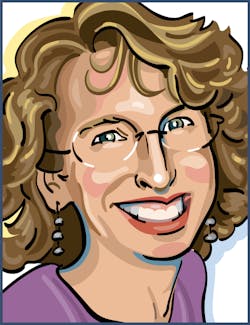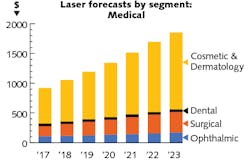Business Forum: Marketplace Seminar speakers bullish on bio

Again and again, speakers at the 2018 Lasers & Photonics Marketplace Seminar demonstrated confidence in the future of bio-optics and -photonics. The seminar took place January 29th at the Marriott Marquis, during SPIE Photonics West.
For instance, Allen Nogee, president of Laser Markets Research, gave an overview of the global laser markets and reported a 10% increase in medical lasers from 2016 to 2017 overall, and during that same time period revenue growth of 18% in lasers for aesthetic applications. The growth has been driven by increasing disposable income and acceptance of such procedures (including interest among younger people), as well as improved treatments that minimize patient recovery time.
The seminar’s Executive Panel, titled “Global laser markets and technology trends—what is happening and what to expect,” featured leaders from four of the industry’s most influential suppliers—all of whom see rosy prospects for biomedical optics. Moderator Martin Seifert, Executive Advisor with Booz Allen Hamilton, led the discussion, during which Berthold Schmidt, CTO of Trumpf’s Laser Division, pointed out continuing “growth opportunities in bio.” Another panelist, Dave Allen, VP and General Manager of Spectra-Physics Lasers/MKS Instruments, agreed, noting that while biomedical and life sciences markets are smaller than industrial markets for lasers, they are nonetheless worthwhile. Meanwhile, Sri Venkat, Senior VP & General Manager of High Power Fiber Lasers & Global CO2 Lasers at Coherent, declared himself “optimistic,” stating that biophotonics innovations will result in widespread applications advancement; and Basil Garabet, President and CEO of NKT Photonics, rated himself as “very optimistic” regarding biophotonics. Venkat noted the great potential for biomedical lasers on the African continent, while Garabet shared his assessment of opportunity in Asia, impelled by an aging population and overall lifestyle improvements, particularly in relation to eye care.
The panelists also touched on two areas addressed in an afternoon talk by Praveen Arany, DDS, Ph.D., president-elect of the World Association for Laser Therapy: Venkat mentioned opportunities in dentistry, while Allen admitted regulatory issues make for a long development cycle that challenges many companies. Arany, who is working on light stimulation of adult stem-cell growth for tooth repair, said that some tools for photobiomodulation (PBM) therapy (formerly known as low-level light therapy [LLLT]) may be able to bypass the lengthy regulatory process required for FDA clearance and approval: The Center for Devices and Radiological Health’s (CDRH’s) compliance policy may admit certain PBM devices as general wellness products that have an intended use relating either to “maintaining or encouraging a general state of health or a healthy activity,” or to “the role of healthy lifestyle with helping to reduce the risk or impact of certain chronic diseases or conditions and where it is well understood and accepted that healthy lifestyle choices may play an important role in health outcomes for the disease or condition,” per CDRH. (Stay tuned for more on this, as there may well be a significant policy change as early as summer 2018, preceded by an open comments phase where you, Dear Reader, will have the opportunity to affect outcomes.)
Arany illustrated PBM therapy’s tremendous potential for human health by presenting an overview of applications, and reporting the results of clinical trials demonstrating effectiveness for treatment of painful inflammation and ulceration of mucous membranes in the mouth (oral mucositis) that affects radiation, chemotherapy, and transplant patients; neck and back pain; concussions; and post-traumatic stress disorder (PTSD).
He emphasized that while historically we have not had a good understanding of how PBM therapy works, newer research has revealed not only the operation of several key molecular mechanisms, but also has uncovered discrete clinical and molecular biomarkers able to guide safe and effective therapy, and begun enabling optimization of dosing and of site-specific PBM mechanisms (both pathophysiological and anatomical).
By the way, while Nogee forecasted that the dental market will experience the least aggressive growth in the next five years among the top four segments of the medical laser market that he identified (see figure), he still expects dental applications to expand 2.4%. At 13.2% CAGR, cosmetic and dermatology applications will lead the pack of laser applications, followed by surgery (11.6%) and ophthalmology (8.4%).
For our full coverage of the 2018 Lasers & Photonics Marketplace Seminar, read the report online at https://goo.gl/bLM5PR.

Barbara Gefvert | Editor-in-Chief, BioOptics World (2008-2020)
Barbara G. Gefvert has been a science and technology editor and writer since 1987, and served as editor in chief on multiple publications, including Sensors magazine for nearly a decade.
